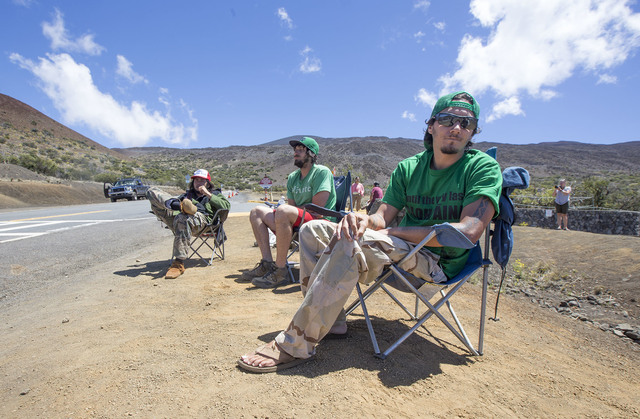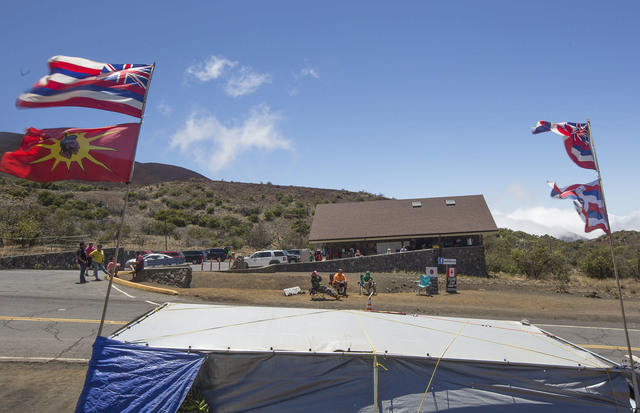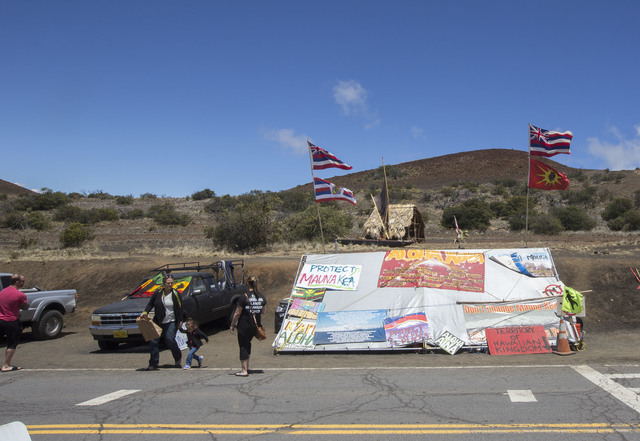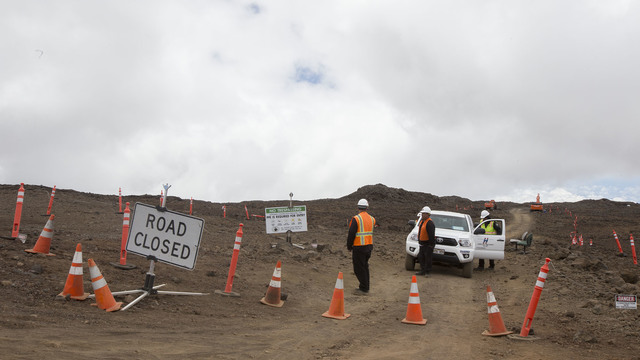Stalemate continues atop Mauna Kea
It’s been more than 70 days since tractor-trailers carrying heavy equipment ascended Mauna Kea’s summit to begin pre-construction of one of the world’s largest telescopes, sparking protests that ultimately brought the $1.4 billion project to a halt.
ADVERTISING
Today, the standoff between the Thirty Meter Telescope and those fighting to stop it continues, with no end in sight.
Outside the Mauna Kea Visitor Information Center, a small group of protesters, mostly Native Hawaiians who call themselves protectors of the mountain they consider sacred, maintain a 24-hour presence, prepared for the day TMT comes back to build.
Meanwhile, 3,950 feet above, near the summit, security guards watch over the project site.
Protest organizer Kaho‘okahi Kanuha, who was one of the 31 people arrested April 2 for blocking the roadway, described the situation as a waiting game.
“It’s going to be a battle of the wills in a sense,” he said. “How long can we last and stay here and sacrifice, like we’ve been sacrificing for the past 70 days, when it comes to jobs and family and things like that? How long can we take a stand?”
So far, TMT has not announced plans to resume grading and grubbing work. And for opponents, when that happens doesn’t really matter.
“All we know is they’re planning to do construction and we’re going to stop it,” Kanuha said.
Project manager Gary Sanders said in a statement that the TMT location is a construction site and it is standard procedure to have security for health and safety.
“Round-the-clock security is monitoring the equipment on site to ensure it is secure and kept in good condition,” he said.
TMT declined to provide information on security costs.
The current lull in activity has resulted in many protesters heading back to their jobs and families. Kanuha said his group has told its supporters to save their resources and time for when it’s really needed.
“And that, we anticipate, should be coming very, very soon … I don’t really see them waiting past mid-June,” he said.
For the core group of between 10 and 15, sacrifices have been made.
Bronson Kobayashi was living on Maui when he saw news of the arrests on TV. He quit his job as an intern with the Department of Land and Natural Resources, moved home and has since spent more than 50 days on the mountain. Like others, he has no plans to stand aside, even if it results in his arrest.
“When the big kahea (call) goes out, we know thousands are coming,” he said.
On March 26, Kanuha left his job as a preschool teacher at Punana Leo o Kona. The school, he said, supports what he is doing and has given him an extended leave of absence. What he is doing may seem like a large sacrifice for an outsider looking in. However, he sees it as a personal responsibility.
“I know that we’ve been put in this place at this time for this reason,” he said.
Daily life for this group consists of visiting with tourists, sharing meals, praying and waiting. Most days, only a handful of people can be found at the camp, which is located just across the road from the visitor center and features a living room-sized tent covered in signs and flags, complete with a cooking area, chairs and cots. On the hillside above the camp, protesters have built a traditional hale out of ohia wood.
On Thursday, Day 71 of the standoff, about 10 people, including a few children, could be found in and around the camp. A pot of hot chowder, delivered by one of the team’s supporters, was on the menu for lunch.
At the end of each day, the protesters retire to their cars to sleep.
In an email Saturday, DLNR spokeswoman Deborah Ward said the area is not permitted for camping but did not respond to the Tribune-Herald’s questions about why the department has allowed the protesters to remain at the site.
“Both state and county officials are monitoring the situation,” she wrote.
Last week, Gov. David Ige announced his vision for better stewardship of Hawaii’s tallest mountain, including establishing a Mauna Kea Cultural Council and decommissioning three telescopes by the time TMT is complete. He also promised to protect the rights of TMT to proceed with construction, as well as opponents to peacefully protest.
While some applauded the governor, many opponents felt he contradicted himself. They said any plan that still allows for the construction of TMT, the largest telescope yet, is unacceptable. Hilo resident Pono Kuikahi comes up the mountain approximately four days per week, sharing his message with people from around the world.
“Everyone has their own mountain, their own temple,” he tells interested visitors. “Nobody wants (the telescope) on top of theirs. It doesn’t have to be a mountain, just a sacred place, wherever it may be. This is ours. This is our spiritual place.”
Asked what he’ll do if the standoff lasts a year, or two years, Kuikahi said, “Then we’ll be here for a year.”
Will Falk, a writer and former public defender, traveled from California to Hawaii last month to live on the mountain and support community members in their fight to stop TMT. While things have been peaceful thus far, he worries that may change.
“I get worried that when push comes to shove things could get nastier up here,” he said. “So far, the aloha tactic has been effective, and I hope that it remains effective. But I guess that will be up to the police.”
Echoing previous statements, Kanuha said he and the others are not against science or the TMT, only the location.
“We’re against an 18-story building being on top of this mountain,” he said. “If they wanted to build an 18-story cultural site on the mountain, a cultural center, we’d be against it. It’s absolutely too big.”
“We’re here simply for the love of our land, nothing else. Not because we’re against anything, we’re not really anti anything. We’re just pro-Hawaii, pro-protecting our land, our natural resources, our sacred sites. And this will set a precedent, whether good or bad.”
Email Chris D’Angelo at cdangelo@hawaii tribune-herald.com.







